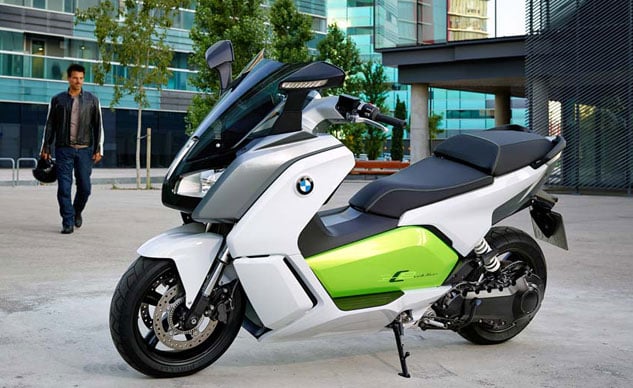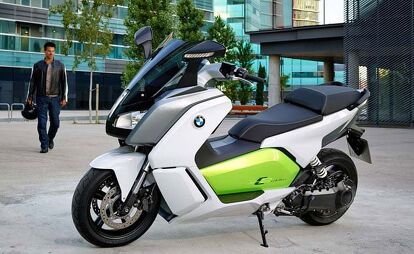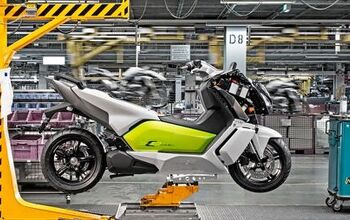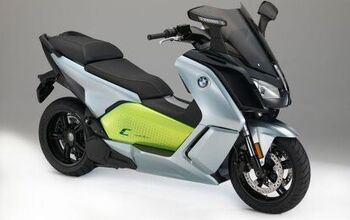2014 BMW C Evolution Electric Scooter Revealed

BMW has expanded its maxi-scooter lineup with a new electric-powered model. Officially revealed after a year of testing at various events in Europe such as the 2012 London Olympics, the BMW C evolution is now ready for production, joining the gas-powered C650GT and C600 Sport.
The C evolution is powered by a liquid-cooled permanent magnet synchronous motor claiming an European Union-rated 15 hp, though if you really strain the motor peak output can reach 47 hp. Peak torque is claimed to be 53 ft-lb. BMW claims this will be enough to propel the C evolution to an electronically-limited maximum speed of 75 mph. BMW also boasts a 0-50 kph (31 mph) time of 2.7 seconds and a 0-100 kph (62 mph) time of 6.2 seconds, acceleration the company compares to a gas-powered 600cc scooter.
The motor is powered by a 8kWh lithium-ion battery, with its die-cast aluminum casing also serving as the main component of the chassis. BMW says the battery can get a full charge in four hours through a domestic 220V socket with a 12A current (or three hours with a 220V/16A outlet), which should be enough for a range of 62 miles.
As with many modern two-wheelers, the C evolution offers multiple ride modes; the main difference is in addition to altering performance, the C evolution’s four ride modes control energy regeneration. Besides connecting to a power outlet, the C evolution can regain energy through regenerative braking or by closing the throttle and harnessing energy from coasting (although doing so does introduce a braking effect.)
Road mode offers maximum acceleration, full energy regeneration ability from braking and 50% regeneration while coasting. Eco Pro mode restricts acceleration to maximize energy regeneration. Sail mode minimizes energy regeneration from coasting, so a rider can coast without as much deceleration. Dynamic mode combines full acceleration with a somewhat vaguely-described “high degree of recuperation.”
As we mentioned, the battery casing is the main part of the chassis, though the trade-off is a lack of storage space under the seat. The pillion seat does lift up to reveal a storage area while a smaller storage compartment is built into the back of the front shield. The large battery is also a contributing factor to the C evolution’s claimed weight of 584 pounds, making it 9 pounds heavier than the C650GT’s claimed wet weight and 35 pounds heavier than the C600 Sport.
The steering head’s steel tubing directly attaches to the front of the battery casing and the single-sided swingarm connecting at the rear. The front wheel is suspended by an upside-down fork while a spring strut serves as rear suspension.
Like all BMW two-wheelers, the C evolution comes standard with anti-lock brakes. The C evolution also uses BMW’s Traction Control Assist technology, a form of traction control that limits motor torque to compensate for wheel slippage.
Other features include a TFT color display, LED daytime running lights and heated grips. the TFT screen displays data such as speed, battery charge status, power consumption, range and voltage of the on-board electrical system. The screen also displays a reversing aid to help move backwards at slow-speed.
The 2014 BMW C evolution will be offered in Light White with Electric Green. Pricing and availability will be announced later.
[Source: BMW]

Dennis has been a part of the Motorcycle.com team since 2008, and through his tenure, has developed a firm grasp of industry trends, and a solid sense of what's to come. A bloodhound when it comes to tracking information on new motorcycles, if there's a new model on the horizon, you'll probably hear about it from him first.
More by Dennis Chung











































































Comments
Join the conversation